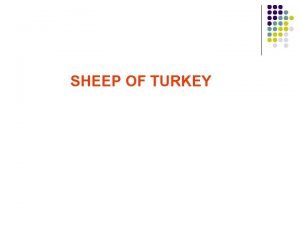Sheep Production Sheep Diseases Sheep Diseases Maggots Fly












- Slides: 12

Sheep Production Sheep Diseases

Sheep Diseases Maggots / Fly Strike � Maggots are the larvae (young) of the blowfly or the Green Bottle Fly. � The fly is attracted to odours in the fleece, and they lay their eggs on dung–soiled wool.


Sheep Diseases - Flystrike Fly strike can be prevented by ◦ Dipping in the Summer ◦ Trimming excess wool around the tail ◦ Tail docking ◦ Grazing management (to prevent scour) An affected sheep is usually quite restless and scratches the affected area frequently. The area may appear green and wet. Maggots should not be ignored and can often be fatal!


- Worms � Nearly all sheep carry intestinal parasites / worms. � The older / more mature the animal the less worms. � This is because older animals develop a certain immunity to worms. � Worms can only be controlled effectively with both drugs and good pasture management. � All sheep should be dosed regularly and pastures managed as to prevent the spread of worms.

Sheep Diseases Liver Fluke � This is a “flat worm” which can cause death to sheep or simply reduce thriftiness and lower the quality of the carcase. � Both worms and liver fluke cannot reproduce inside the sheep (host) so the number of larvae eaten determine the extent of the disease. Footrot � Footrot is a very serious problem on Irish Farms. � Footrot is caused by a bacteria, in fact many different types of bacteria.


Foot rot �Footrot causes lameness, serious pain, reduced food intake, in-activity and can lower fertility in rams. �You can spot an affected sheep by seeing them kneeling down while grazing. �Can be prevented by paring hooves and using a foot bath once a month with copper sulphate

Bluetongue �Bluetongue is an insect–transmitted, viral disease of sheep, cattle, goats, and other ruminants. �A bluetongue virus infection causes inflammation, swelling, and haemorrhage of the mucous membranes of the mouth, nose, and tongue. �Inflammation and soreness of the feet also are associated with bluetongue. �In sheep, the tongue and mucous membranes of the mouth become swollen, hemorrhagic, and may look red or dirty blue in colour, giving the disease its name. �Bluetongue viruses are spread from animal to animal by biting gnats. �Animals cannot directly contact the disease from other animals.


Orf �Orf is a viral zoonose and is highly infectious �Symptoms: scabby mouth, ulcers, sore mouth and udders and feet maybe infected �Can be prevented by vaccinating ewes 4 – 6 weeks before lambing and lambs should be vaccinated after 4 weeks






















